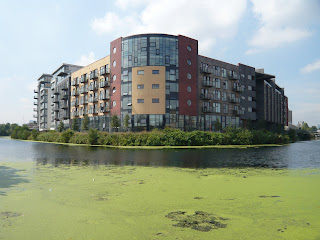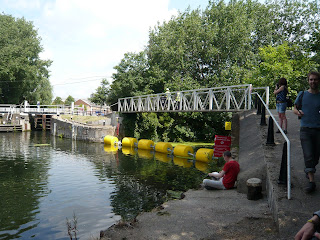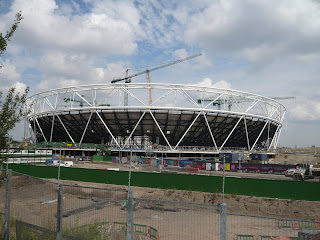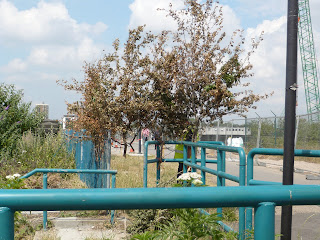
Dalston Mill, London, 2009. Photo from Londonist.
When I was researching my recent feature on urban farming (Icon 072; not online yet, sadly), the same name kept coming up: Cuba. Cuba, it was said, was the face of the future: urban populations were effectively supplementing their diets from smallholdings within city limits, and were doing so with high yields achieved without agrochemicals. I now read on Carolyn Steel's blog that this isn't strictly true: Cuba's urban farms supply only 5% of the nation's food, and 75% of Cuba's farmers use agrochemicals. More would if they could. It's a great shame.
This is a problem with urban farming that I hinted at in the piece I wrote for Icon 072 and didn't really have the space to explore fully. Urban farming was forced on Cuba; whatever its admirable achievements, I'm sure many of those courtyard smallholdings would become carparks with the end of the economic crisis. They are a contingency measure until better times arrive.
Now, there are very good reasons to grow more food inside cities, and to encourage people to grow some of their own food where they can. We do not want to continue to be at the mercy of a bloated, destructive and wasteful industry that gulps petrochemicals, destroys ecosystems and ruins the lives of thousands. As well as being ethically ropey and bad for our health, the food industry is very fragile, with long, tenuous supply lines and vast resource requirements that make it very vulnerable to exogenous shock and sudden collapse. Our dependence on industrialised food is a huge risk; self-reliance, on an individual and civic scale, is a virtue.
But the proponents of urban farming often muddle up doing it because we must (that is, we face shortages if we do not) and doing it because we should (self-reliance being a virtue, food security being desirable and so on) - necessity and desirability. And it's the questions of necessity that tend to be the most powerful arguments: no one wants to face shortages. But if people see urban farming as only a necessity, it will only ever be seen as an emergency response to a crisis, to be rolled back when (if) more secure times return. This appears to be the condition Cuba is in. But that simply sets society back on the road to consumer-dependence of food produced invisibly elsewhere.
Moving to a more diverse and stable system of food production - including some urban farming - has to accent that is is a desirable option in good times and bad.
Hipsterising the Eschaton
Which brings me to the second prong of this pitchfork argument. I'm not terrifically impressed by the Barbican's "recreation" of Agnes Denes' 1982 urban art installation Wheatfield - A Confrontation. Here's a gallery of pictures from Londonist, including the one I borrowed at the top of this post; here's a gallery from the AR. Maybe I'm missing something, maybe it the photography. But it strikes me as pitiful. Denes' original was a flowing field on a sweep of land worth millions of dollars, with Manhattan as a backdrop. This "recreation" is a mangy rug in an enclosed patch of Dalston. It lacks all of the impact of the original.But the purpose here is education as well as spectacle. It's a demonstration of urban farming; the wheat produced by the field will be ground in the windmill that has been built on site by voguish French practice EXYZT. Sadly, the windmill is not at all interesting. It is simply a windmill. The project has some merit in that it gives a small idea of how urban food production could be integrated with public social space.
But the aesthetics are, regrettably, an instance of apocalypse chic. For some reason, when young architecture practices confront the planet's combined crises, the reference tool they reach for is Mad Max rather than, say, anything attractive or optimistic. In an effort to make the project visibly post-crisis, it is deliberately informalised, made to look uglier, cheaper and more improvised than it could be. In order to make this palatable, it is made to be "fun", usually by installing a turntable. The overall idea appears to be to suggest that the chaotic transition from petroeconomy to whatever comes next is going to be like some kind of hipster yard party.
This deliberately informalised approach is delusional and counterproductive. It just makes necessary measures look like transitional patch-ups and workarounds, in place until normal service is resumed. It falls into the trap I described above, appealing to necessity rather than desirability. Why stick with this jerry-rigged arrangement when we could build version 2.0 of the industry that has given us individually wrapped bananas airfreighted from Kenya and the Turkey Twizzler?
You might argue that transitional jerry-rigging will be necessary for a time, and the aesthetics come later. That's not a bad point, but we know how to build a windmill out of scaffolding, and we did not need EXYZT to show us. Architects should be busying themselves with making a post-crisis future appealing, and doing so in a way that stretches beyond putting in a turntable. The model should be post-War planning, utopianism, not Waterworld. The future should be well-made and attractive.


















































